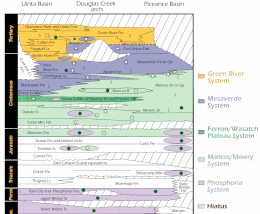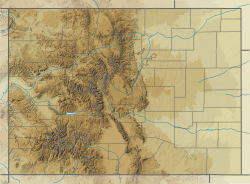Mancos Shale
| Mancos Shale | |
|---|---|
| Stratigraphic range: Mid Albian-Campanian ~ | |
 Mancos Shale at its type location just north of Mancos, Colorado | |
| Type | Geologic formation |
| Sub-units | See text |
| Underlies | Mesaverde Formation |
| Overlies | Dakota Group |
| Lithology | |
| Primary | Shale |
| Location | |
| Coordinates | 37°21′11″N 108°17′49″W / 37.353°N 108.297°W |
| Region | Arizona, Colorado, New Mexico, Utah, Wyoming |
| Country | |
| Extent | Basin and Range, Colorado Plateau & San Juan Mountains Provinces |
| Type section | |
| Named for | Mancos, Colorado |
The Mancos Shale or Mancos Group is a Late Cretaceous (Upper Cretaceous) geologic formation of the Western United States.
The Mancos Shale was first described by Cross and Purington in 1899[1] and was named for exposures near the town of Mancos, Colorado.
Geology
[edit]
The unit is dominated by mudrock that accumulated in offshore and marine environments of the Cretaceous North American Inland Sea. The Mancos was deposited during the Cenomanian (locally Albian) through Campanian ages, approximately from 95 million years ago (Ma) to 80 Ma.
Stratigraphically the Mancos Shale fills the interval between the Dakota and the Mesaverde Group.[2]
The lower marine Mancos Shale conformably intertongues with terrestrial sandstones and mudstones of the Dakota and in its upper part grades into and intertongues with the Mesaverde Group. The shale tongues typically have sharp basal contacts and gradational upper contacts. Whereas in the plains east of the Rocky Mountains certain mappable marine shales are identified as formations (e.g., Skull Creek, Graneros), correlated deposits within the distribution of the Mancos are named as tongues of the greater Mancos Formation.
Thus, the classification broadly corresponds with the Colorado Group classification of the Great Plains region. Accordingly, various units of the Colorado Group are recognized within the Mancos in those areas where their distinct facies can be recognized.[3]
Occurrences
[edit]

The Mancos occurs in the Basin and Range Province, the Colorado Plateau Province, and the San Juan Mountains Province.
Structural basins
[edit]The Mancos is a diverse unit, with dozens of named subunits in different structural basins that often intertongue with other formations.[4] The subunits and intertonguing formations (in italics) in each basin, in stratigraphic order, are:
|
|
|
|
History of investigation
[edit]The Mancos Shale was first named by Charles Whitman Cross and C.W. Purington in 1899, for outcrops near the town of Mancos, Colorado and along the Mancos River nearby. The two geologists also traced the unit into the Telluride, Colorado area.[1] W.T. Lee had traced the unit north into the Grand Mesa area, defining it as all marine shale between the Dakota and the Mesaverde.[19] It was subsequently traced into Utah[20] and New Mexico.[21]
During their work in New Mexico in 1924, J.B. Reeside, Jr., and F.H. Knowlton found that the Mancos Shale could be divided into biostratigraphic layers corresponding closely to formations of the Colorado Group further east. By 1944, Rankin had concluded that most of the formations of the Colorado Group could be identified as lithostratigraphic members of the Mancos Shale as well.[3] The unit was raised to group rank by C.E. Jamison in 1911,[22] and is sometimes given group rank in New Mexico[23] and Utah[24] as well.
See also
[edit]- List of fossiliferous stratigraphic units in Arizona
- List of fossiliferous stratigraphic units in Colorado
- List of fossiliferous stratigraphic units in New Mexico
- List of fossiliferous stratigraphic units in Utah
- List of fossiliferous stratigraphic units in Wyoming
References
[edit]- ^ a b Cross, C.W.; Purington, C. W. (1899). "Description of the Telluride quadrangle, Colorado". United States Geological Survey Atlas. Vol. 57.
- ^ Weimar, R.J. (1960). "Upper Cretaceous Stratigraphy, Rocky Mountain Area". AAPG Bulletin. 44: 1–20. doi:10.1306/0BDA5F6F-16BD-11D7-8645000102C1865D.
- ^ a b c Rankin, Charles H. (1944). "Stratigraphy of the Colorado Group, Upper Cretaceous, in Northern New Mexico" (PDF). New Mexico Bureau of Mines and Mineral Resources Bulletins (20). New Mexico School of Mines: 5. Retrieved 2018-08-13.
...that all divisions of the Colorado group (Mancos shale) as described in southern Colorado, except the Fort Hays limestone and the Apishapa shale, can be recognized in northern New Mexico.
- ^ "Colorado River Basin Stratigraphy: Mancos Shale" United States Geological Survey
- ^ Kirkland, J.I. (1991). "Lithostratigraphic and biostratigraphic framework for the Mancos Shale (Late Cenomanian to Middle Turonian)". Geological Society of America Special Paper. 260: 88. ISBN 978-0-8137-2260-3. Retrieved 16 September 2021.
- ^ Landis, E.R.; Dane, C.H. (1967). "Geologic map of the Tierra Amarilla quadrangle, Rio Arriba County, New Mexico, with description". New Mexico Bureau of Mines and Mineral Resources Geologic Map. 19. Retrieved 17 September 2021.
- ^ Lisenbee, Alvis; Maynard, Steve (May 2001). "Geologic Map of the Captain Davis Mountain Quadrangle, Santa Fe County, New Mexico" (PDF). New Mexico Bureau of Geology and Mineral Resources Open-file Digital Geologic Map. OF-GM 48. Retrieved 16 September 2021.
- ^ Nuccio, Vito F.; Condon, Stephen M. (1996). "Burial and thermal history of the Paradox Basin, Utah and Colorado, and petroleum potential of the Middle Pennsylvanian Paradox Basin". United States Geological Survey Bulletin. 2000-O: O6. doi:10.3133/b00O.
- ^ Fisher, D.J.; Erdmann, C.E.; Reeside, J.B. Jr. (1960). "Cretaceous and Tertiary formations of the Book Cliffs, Carbon, Emery, and Grand Counties, Utah, and Garfield and Mesa Counties, Colorado". United States Geological Survey Professional Paper. Professional Paper. 332. doi:10.3133/pp332.
- ^ Johnson, S.Y.; Johnson, R.C. (1991). "Stratigraphic and time-stratigraphic cross sections of Phanerozoic rocks along line A-A', Uinta and Piceance basin area-Eagle basin, Colorado, to eastern Basin-and-Range area, Utah". U.S. Geological Survey Miscellaneous Investigations Series Map. I-2184-A. Retrieved 15 September 2021.
- ^ a b Franczyk, Karen J. (1989). "Depositional controls on the late Campanian Sego Sandstone and implications for associated coal-forming environments in the Uinta and Piceance basins". United States Geological Survey Bulletin. 1787-F. doi:10.3133/b1787F.
- ^ Dane, C.H. (1948). "Geology and oil possibilites of the eastern side of the San Juan basin, Rio Arriba County, New Mexico". U.S. Geological Survey Oil and Gas Investigations Map. OM-78. Retrieved 16 September 2021.
- ^ Owen, Donald E.; Forgas, Angelique M.; Miller, Shawn A.; Stelly, Ryan J.; Owen, Donald E. Jr. (2005). "Surface and subsurface stratigraphy of the Burro Canyon Formation, Dakota Sandstone, and intertongued Mancos Shale of the Chama Basin, New Mexico" (PDF). New Mexico Geological Society Field Conference Series. 56: 218–226. Retrieved 15 September 2021.
- ^ O'Sullivan, R.B.; Repenning, C.A.; Beaumont, E.C.; Page, H.G. (1972). "Stratigraphy of the Cretaceous rocks and the Tertiary Ojo Alamo Sandstone, Navajo and Hopi Indian Reservations, Arizona, New Mexico, and Utah". United States Geological Survey Professional Paper. Professional Paper. 521-E. doi:10.3133/pp521E.
- ^ Landis, Edwin R.; Dane, C.H.; Cobban, William Aubrey (1973). "Stratigraphic terminology of the Dakota Sandstone and Mancos Shale, west-central New Mexico". United States Geological Survey Bulletin. 1372-J. doi:10.3133/b1372J.
- ^ Hook, Steven C. (1983). "Contributions to mid-Cretaceous paleontology and stratigraphy of New Mexico — part II" (PDF). New Mexico Bureau of Mines & Mineral Resources Circular. 185: 15–16. Retrieved 17 September 2021.
- ^ Walton, P.T. (1944). "Geology of the Cretaceous of the Uinta basin, Utah". Bulletin of the Geological Society of America. 55 (1): 91–130. Bibcode:1944GSAB...55...91W. doi:10.1130/GSAB-55-91.
- ^ Molenaar, Cornelius M.; Wilson, B.W. (1990). "The Frontier Formation and associated rocks of northeastern Utah and northwestern Colorado". United States Geological Survey Bulletin. 1787-M. doi:10.3133/b1787M.
- ^ Lee, Willis Thomson (1912). "Coal fields of Grand Mesa and the West Elk Mountains, Colorado". United States Geological Survey Bulletin. 510. doi:10.3133/b510. hdl:2346/65145.
- ^ Lupton, C.T. (1914). "Oil and gas near Green River, Grand County, Utah". United States Geological Survey Bulletin. 541-D. doi:10.3133/b541D.
- ^ Reeside, John B. Jr.; Knowlton, F.H. (1924). "Professional Paper". United States Geological Survey Professional Paper. 134. doi:10.3133/pp134.
- ^ Jamison, C.E. (1911). "Geology and Mineral Resources of a Portion of Fremont County, Wyo". Wyoming Geological Survey Bulletin. 2B. Retrieved 21 September 2021.
- ^ Zakis, William (1952). "Table Mesa Oil Field San Juan County, New Mexico". Geological Symposium of the Four Corners Region. Retrieved 21 September 2021.
- ^ Roberto, Sarmiento (1957). "Microfossil Zonation of Mancos Group". AAPG Bulletin. 41. doi:10.1306/0BDA5927-16BD-11D7-8645000102C1865D.
- Shale formations of the United States
- Upper Cretaceous Series of North America
- Cretaceous United States
- Campanian Stage
- Cenomanian Stage
- Coniacian Stage
- Santonian Stage
- Turonian Stage
- Cretaceous Arizona
- Cretaceous Colorado
- Cretaceous formations of New Mexico
- Cretaceous geology of Texas
- Cretaceous geology of Utah
- Cretaceous geology of Wyoming
- Geology of the Rocky Mountains



